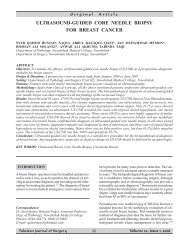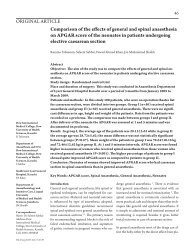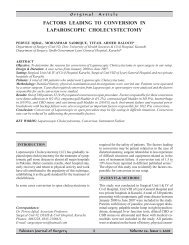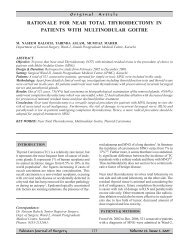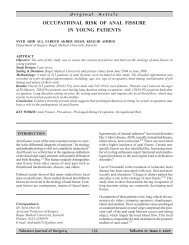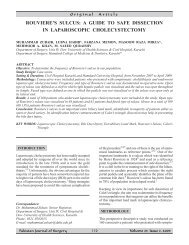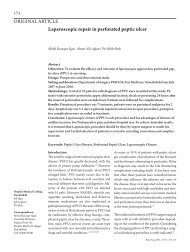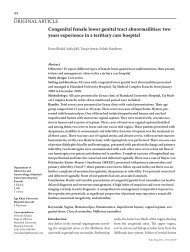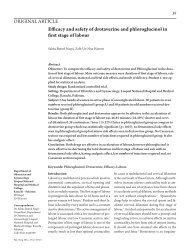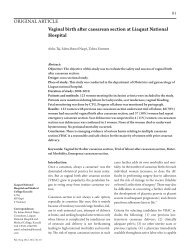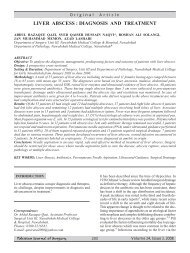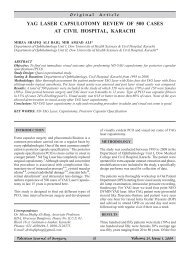Non surgical modalities of treatment for haemorrhoids
Non surgical modalities of treatment for haemorrhoids
Non surgical modalities of treatment for haemorrhoids
Create successful ePaper yourself
Turn your PDF publications into a flip-book with our unique Google optimized e-Paper software.
INTRODUCTION<br />
Haemorrhoids are dilated veins occuring in relation to<br />
the anus. 1 The term <strong>haemorrhoids</strong> have different meaning<br />
to different people, many people use these words to<br />
describe the wide variety <strong>of</strong> anorectal conditions. 2<br />
Haemorrhoids are common in both men and women.<br />
About half <strong>of</strong> the population have <strong>haemorrhoids</strong> by age<br />
50. 3 Common presenting symptoms are bleeding per<br />
rectum, prolapse, itching and mucoid discharge. Caution<br />
by clinicians must be used not to misdiagnose other<br />
anorectal problems as <strong>haemorrhoids</strong>. 4 Although many<br />
people have <strong>haemorrhoids</strong>, not all express symptoms. 3<br />
Haemorrhoids symptoms have been known from time<br />
immemorial, these are considered to be a wide spread<br />
problem which is progressive if untreated. 5 Diagnosis<br />
is clinical and always reached after having ruled out<br />
other locoreginal pathology. 6 Treatment is oriented to<br />
the stage <strong>of</strong> disease 1st degree <strong>haemorrhoids</strong> are treated<br />
conservatively. In addition to high fibrediet, sclerotherapy<br />
is used. Second degree <strong>haemorrhoids</strong> are treated by<br />
rubber band ligation, 3rd and 4th degree <strong>haemorrhoids</strong><br />
usually need surgery. 7
METHODOLOGY<br />
This prospective study was conducted at Surgical Unit<br />
I, Chandka Medical College Hospital, Larkana from<br />
April 2004 to March 2007. Three hundred patients<br />
presented with various degrees <strong>of</strong> internal <strong>haemorrhoids</strong><br />
were included while patients with 4th degree and interoexternal<br />
<strong>haemorrhoids</strong> were excluded from the study.<br />
Most <strong>of</strong> the patient were dealt as Out Patient cases and<br />
treated by non <strong>surgical</strong> methods <strong>of</strong> <strong>treatment</strong>. The data<br />
was obtained and analyzed by filling a specially designed<br />
pr<strong>of</strong>orma <strong>for</strong> each patient. Assessment <strong>of</strong> the patients<br />
was done by a detailed History and clinical examination.<br />
Investigations like Hemoglobin percentage and Proctoscopy<br />
was per<strong>for</strong>med in all the cases, while sigmoidocolonoscopy<br />
and barium study were added to exclude<br />
proximal inflammatory or neoplastic lesions in suspected<br />
cases. After initial assessment all patients were treated<br />
by different <strong>modalities</strong> <strong>of</strong> non <strong>surgical</strong> <strong>treatment</strong> including<br />
medical <strong>treatment</strong>, injection sclerotherapy and rubber<br />
band ligation. Other non-<strong>surgical</strong> methods are Cryosurgery<br />
and photocoagulation which are not included<br />
in our study because <strong>of</strong> non-availability <strong>of</strong> equipments<br />
at our institute.<br />
RESULTS<br />
A total number <strong>of</strong> 300 patients with different types <strong>of</strong><br />
<strong>haemorrhoids</strong> were included in this study. Their age<br />
ranged from 10-75 years, with mean age <strong>of</strong> 39 Years.<br />
Majority <strong>of</strong> the patients seen between 31-50 years <strong>of</strong><br />
age (Table I). There was male preponderance, among<br />
300 patients 159(53%) were male and 141 patients<br />
(47%) were female (Table II). The male to female ratio<br />
was 1.1:1. Most <strong>of</strong> the patients presented with history<br />
<strong>of</strong> prolapse 160 patients (53.33%), bleeding per rectum<br />
was seen in 24.33%, pruritis ani was associated complaint<br />
in 28.66% and constipation was also associated complain<br />
in 231 patients (77%). Family history <strong>of</strong> <strong>haemorrhoids</strong><br />
was positive in 163 patients (54.33%). All patients<br />
with first, second and third degree <strong>haemorrhoids</strong> were<br />
treated by non <strong>surgical</strong> modality <strong>of</strong> <strong>treatment</strong>. Out <strong>of</strong><br />
300 patients 100 were randomly selected <strong>for</strong> each modality<br />
<strong>of</strong> <strong>treatment</strong> which are frequently available in this<br />
hospital (Table III). To avoid constipation and heavy<br />
lifting <strong>of</strong> objects, eat a balanced high fibre diet, drink<br />
plenty <strong>of</strong> water, fluids, exercise, avoid straining during<br />
defecation, avoid spicy foods, c<strong>of</strong>fee and alcohol, calcium<br />
dobesitate 500mg and Tranexamic acid 500mg <strong>for</strong><br />
bleeding piles are important measures <strong>for</strong> conservative<br />
<strong>treatment</strong> <strong>of</strong> <strong>haemorrhoids</strong>. Out <strong>of</strong> 100 patients who<br />
were given medical <strong>treatment</strong> 65 patients (65%) had<br />
first degree and 35% had second degree <strong>haemorrhoids</strong>.<br />
75% <strong>of</strong> patients responded to medical <strong>treatment</strong> (Table<br />
IV), remaining 25% patients who did not follow general<br />
instructions resulted in failure to medical <strong>treatment</strong>.<br />
Another non <strong>surgical</strong> modality <strong>of</strong> <strong>treatment</strong> is Injection<br />
Sclerotherapy with 5% Phenol in Almond oil which<br />
will cause thrombosis <strong>of</strong> vessels and fibrosis. Among<br />
100 patients who were kept on Injection Sclerotherapy,<br />
36% patients had first degree and 64% had second<br />
degree <strong>haemorrhoids</strong> (Table V).<br />
Every patient was reassessed after six weeks. This<br />
procedure was found successful in 69% patients without<br />
complications, 13 patients had post procedure pain, 7%<br />
developed infection while 11% patients gave no response<br />
to the <strong>treatment</strong> there<strong>for</strong>e needed other <strong>for</strong>ms <strong>of</strong> <strong>treatment</strong><br />
like band ligation and haemorrhoidectomy. Barron’s<br />
Rubber band ligation cause ischaemic necrosis <strong>of</strong> large<br />
first, second and third degree internal <strong>haemorrhoids</strong> is<br />
a widely practiced procedure. Out <strong>of</strong> 100 patients kept<br />
on this <strong>treatment</strong>, 10 patients had first degree, 65 had<br />
second degree while 25 patients were <strong>of</strong> third degree<br />
<strong>haemorrhoids</strong> (Table VI), every patient was reassessed<br />
after three weeks. 86% patients gave satisfactory response<br />
with no complication while 14 patients had post<br />
procedure pain.
DISCUSSION<br />
Haemorrhoids are a common condition in adult population<br />
with prevalence <strong>of</strong> about 4%, only one third <strong>of</strong><br />
patients with symptomatic <strong>haemorrhoids</strong> seek medical<br />
help. 8 Haemorrhoidal disease is a clinical entity which<br />
requires proper <strong>treatment</strong> in its early stage to prevent<br />
complications and to decrease morbidity. Most <strong>of</strong> the<br />
patients in this study 114(44.66%) were between 31-<br />
50 years. There was relatively male preponderance over<br />
females, 53% were male and 47% female. Mean age<br />
was 39 years. In one study mean age found is 44.1 years<br />
and there was also male preponderance. 9 Some thing<br />
coming out <strong>of</strong> anus was the chief complaint in most <strong>of</strong><br />
the patients 153(51%) followed by bleeding per rectum<br />
in 173 patients (57.6%) pruritis ani in 86(28.6%), and<br />
constipation was the associate complaint in 231 patients<br />
(77%). Family history <strong>of</strong> <strong>haemorrhoids</strong> was positive in<br />
163 patients (54.33%). Digital rectal examination and<br />
proctoscopy are important to diagnose the <strong>haemorrhoids</strong><br />
as also mentioned in the literature. 1,3 All patients with<br />
1st and 2nd degree internal <strong>haemorrhoids</strong> were treated<br />
by non <strong>surgical</strong> method <strong>of</strong> <strong>treatment</strong>. Conservative<br />
<strong>treatment</strong> including high fiber-diet and increase fluid<br />
intake and stool s<strong>of</strong>teners were <strong>of</strong>fered to 100 patients<br />
(33.33%) <strong>of</strong> 1st degree <strong>haemorrhoids</strong>, 75 patents (75%)<br />
responded well with no recurrence. Conservative <strong>treatment</strong><br />
include fluid and fiber intake and retraining toilet<br />
habits, use <strong>of</strong> laxatives and local creams. Results highly<br />
corresponds to other studies with this <strong>treatment</strong> modality<br />
was found successful. 10 Out <strong>of</strong> 100 patients (33.33%)<br />
under went injection sclerotherapy 69 patients (69%)<br />
responded well without complications. This sort <strong>of</strong><br />
<strong>treatment</strong> is also recommend by other authors as highly<br />
beneficial <strong>for</strong> 1st and 2nd degree <strong>haemorrhoids</strong> with<br />
satisfactory results. 1,11,12 Out <strong>of</strong> 100 patients, (13%)<br />
had pain, infection seen in 7 patients while (11%) <strong>of</strong><br />
patients gave no significant response ultimately needed<br />
rubber band ligation or surgery. The efficacy <strong>of</strong> this<br />
<strong>for</strong>m <strong>of</strong> <strong>treatment</strong> is also supported by other studies as<br />
well. 5 Banding <strong>treatment</strong> was <strong>of</strong>fered to 100 patients<br />
(33.33%), all were reassessed after every three weeks.<br />
Successful results were obtained in 86 patients (68%)<br />
while 5 patients (5%) developed pain, recurrence was<br />
seen in 9 patients (9%) at two year follow up and surgery<br />
was per<strong>for</strong>med in those patients. Results from this study<br />
are well correlated with the results described by other<br />
authors in which success rate was (92.8%), symptomatic<br />
recurrence was seen in (11.04%) after two years and<br />
(4.13%) patients developed pain. 4 In another study<br />
rubber band ligation found effective mode <strong>of</strong> <strong>treatment</strong><br />
<strong>for</strong> early <strong>haemorrhoids</strong> in (82.2%) <strong>of</strong> patients. 3 According<br />
to some studies only two <strong>of</strong> the non <strong>surgical</strong> procedures<br />
are in general use-rubber band ligation and sclerotherapy.<br />
13 Both procedures share a high recurrence<br />
14,1 5,16<br />
rate.<br />
CONCLUSION<br />
Conservative <strong>treatment</strong> is recommended <strong>for</strong> first and<br />
second degree <strong>haemorrhoids</strong> which sufficiently relieve<br />
symptoms. Injection Sclerotherapy and Banding <strong>treatment</strong><br />
are procedures <strong>of</strong> choice <strong>for</strong> first and second<br />
degree <strong>haemorrhoids</strong>.
REFERENCES<br />
1. Russell R C G, Williams N S, Bulstrode C J K. The<br />
anus and anal canal. In: Bailey and Love’s short<br />
practice <strong>of</strong> surgery; 24th ed. London: Arnold 2004;<br />
1255-62.<br />
2. Dozois R R. Disorders <strong>of</strong> the anal canal. In: Sabiston<br />
DC. Textbook <strong>of</strong> surgery-The biological basis <strong>of</strong><br />
modern <strong>surgical</strong> practice; 15th ed. London: 1997;<br />
1036-37.<br />
3. Gilbere G, Teitelbaum. Haemorrhoids. NIH publication.<br />
No. 05-3021: 2004; 1-5.<br />
4. Schwartz S I, shires G T, Spencer F C. Colon rectum<br />
and anus. In: Schwartz Principles <strong>of</strong> Surgery; 6th<br />
ed. New York: Mc Graw-Hill; 1994; 1222-25.<br />
5. Kirsch J J, Grimm B D. Conservative <strong>treatment</strong> <strong>of</strong><br />
<strong>haemorrhoids</strong>. Wien Med Wochenschr 2004; 154(3-<br />
4): 50-5.<br />
6. Pigot F. Haemorrhoidal disease. Rev Part. 2008;<br />
58(16): 1763-8.<br />
7. Herold A. Theraphy <strong>of</strong> Haemorrhoidal disease.<br />
Chirurg. 2006; 77(8): 737-47.<br />
8. Smud D, Kekez T, Majerovic M, Smud S. Haemorrhoids-diagnosis<br />
and <strong>treatment</strong> options. Lijec Vjesn.<br />
2005; 127(5-6): 129-33.<br />
9. Correa-Rpvelo J M, Tellez O, Maran S, Bahena-<br />
Aponte J A. Surgical <strong>treatment</strong> <strong>of</strong> <strong>haemorrhoids</strong><br />
with rectal mucosal resection using a stapler. Rev<br />
Gastroenterol Mex. 2006; 71(4): 422-27.<br />
10. Scott C Thornton. Haemorrhoids and their symptoms<br />
eMedicine; 2008; 1-13.<br />
11. Al-Fallouji M A R. Common ano-rectal conditions.<br />
In: Post graduate surgery; 2nd ed. Ox<strong>for</strong>d: Butterworth-Heinemann,<br />
1998; 281-82.<br />
12. Farquharson M, Moran B. Surgery <strong>of</strong> anus and<br />
perineum. In: Farquharson’s Text book <strong>of</strong> operative<br />
surgery; 9th ed. New York: 2005; 439-42.<br />
13. Beattie G C, Willson R G, Lundon M A. The contemporary<br />
management <strong>of</strong> <strong>haemorrhoids</strong>. Colorect<br />
Dis 2002; 4: 450-454.<br />
14. Watson N F, Liptrott S, Maxwell-Armstrong C A.<br />
A prospective audit <strong>of</strong> early pain and patient<br />
satisfaction following out-patient band ligation <strong>of</strong><br />
<strong>haemorrhoids</strong>. Ann R Coll Surg Engl 2006; 88:<br />
275-279.<br />
15. Shanmugam V, Thaha M A, Rabindranath K S,<br />
Campbell K L, Steele R J C, London M A. Systematic<br />
Review <strong>of</strong> randomized trials comparing rubber<br />
band ligation with excisional Haemorrhoidectomy.<br />
Br J Surg 2005; 92: 1481-1487.<br />
16. Long man R J, Thomson W H. A prospective study<br />
<strong>of</strong> out come from rubber band ligation <strong>of</strong> piles.<br />
Colorect Dis 2006; 8: 145-148.



